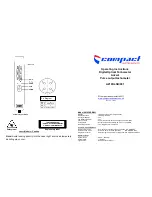
7 Installation of FLUXUS G801
UMFLUXUS_G8V4-6-1EN, 2018-10-10
43
• Prepare the extension cable.
• Cut the external shield and brush it back over the compression part.
• Screw the gasket ring side of the basic part into the junction box.
• Insert the extension cable into the junction box.
• Fix the cable gland by screwing the cap nut onto the basic part.
• Connect the extension cable to the terminals of the transmitter (see Fig. 7.6 and Tab. 7.2).
For the terminal assignment of the transducer cable see Fig. 7.6 and Tab. 7.5.
7.5.2.2
Connection with potential separation
If earthing on the same potential cannot be ensured e.g., in measurement arrangements with long extension cables, the
extension cables and junction box have to be insulated from each other. The junction box and the transmitter have to be
on the same potential. By doing this, no compensation currents can flow to the transmitter via the extension cables.
• Remove the left blind plug for the connection of extension cable (see Fig. 7.7).
• Open the cable gland of the extension cable. The compression part remains in the cap nut.
• Push the extension cable through the cap nut, the compression part and the basic part.
Attention!
For good high frequency shielding, it is important to ensure good electrical contact between the exter-
nal shield and the cap nut (and the junction box).
Tab. 7.2: Terminal assignment (extension cable, KL2)
terminal
connection
TV
white or marked cable (core)
TVS
white or marked cable (internal shield)
TRS
brown cable (internal shield)
TR
brown cable (core)
cable gland
external shield
Tab. 7.3: Terminal assignment (transducer cable)
terminal
connection
V
transducer
(core)
VS
transducer
(shield)
RS
transducer
(shield)
R
transducer
(core)
Note!
For the installation of the transducers on pipes with cathodic corrosion protection see document
TIFLUXUS_GalvSep.
Attention!
Observe the "Safety Instructions for the Use in Explosive Atmosphere" (see document SIFLUXUS).
















































